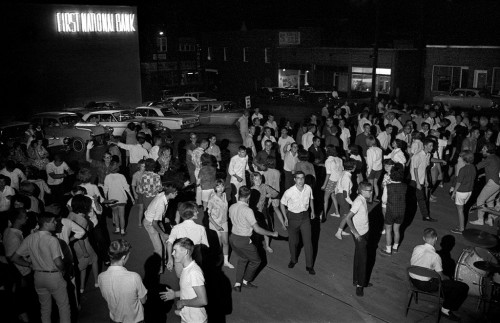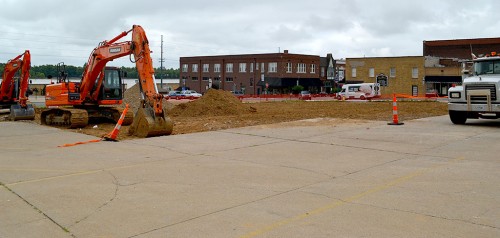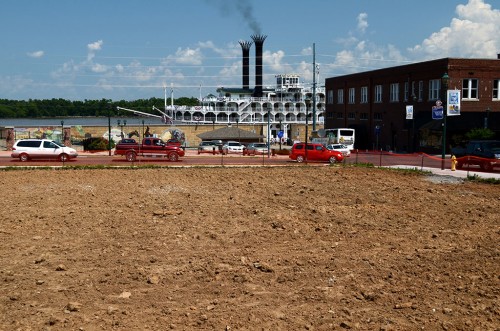 I usually complain when an old building in Cape is turned into a parking lot, but I never had much of a feeling one way or another about the First National Bank, which later became the Cape Girardeau Convention and Visitors Bureau.
I usually complain when an old building in Cape is turned into a parking lot, but I never had much of a feeling one way or another about the First National Bank, which later became the Cape Girardeau Convention and Visitors Bureau.
In fact, the only photos I took of the building at the corner of Broadway and Main might have been the night the Teen Age Club was rocking so hard the dance was moved to the parking lot of the old bank.
Lynch and Baughn covered the history
 Missourian bloggers Fred Lynch and James Baughn did a good job of digging up the history of the bank, which was built in 1956. You can go to Fred’s blog to find all the links and photos, including recent ones taken while it was being razed. By the time I got to town, it was pretty much all over. This was taken July 5, 2013.
Missourian bloggers Fred Lynch and James Baughn did a good job of digging up the history of the bank, which was built in 1956. You can go to Fred’s blog to find all the links and photos, including recent ones taken while it was being razed. By the time I got to town, it was pretty much all over. This was taken July 5, 2013.
American Queen nice surprise
 When I went down to pick up an order at Broussard’s on July 7, I saw a reason not to lament the loss of a rather nondescript bank building. Anyone parking in that lot in the future will have a great view of riverboats like The American Queen. The Buckner building on the corner is vacant now.
When I went down to pick up an order at Broussard’s on July 7, I saw a reason not to lament the loss of a rather nondescript bank building. Anyone parking in that lot in the future will have a great view of riverboats like The American Queen. The Buckner building on the corner is vacant now.
(I’ll have some shots of The Queen later. You can click on any of the photos to make them larger.)

They should make it a nice little green space park. Where you could sit and watch the river go by. If only…..
In fairness, you can’t see the river from there. The floodwall is in the way. Parking is pretty tight downtown, so I don’t mind them tearing down a building that wasn’t all that attractive to begin with (think Soviet architecture) to make it possible for more people to enjoy activities on the river.
I’ve always thought that the city should work with the railroad to build a tunnel for the railroad against the flood wall right to the north of Broadway. I like the the way the railroad passes underground in front of the Gateway Arch in St. Louis.
Dealing with the railroad in such a way would allow a park that has land that is flush with the top of the flood wall and would provide an excellent view of the riverfront up and down the river.
I remember my grandparents taking me to the Grand Opening festivities.
I remember the original 1st national bank building located on Main Street.
There was a barber shop in the basement where I got my hair cut.
The interior of the bank was scary to a 6 year old kid. I was afraid the giant columns would fall down and crush everyone.
If I remember correctly there was a dental office on the second floor, but that was one memory I tried to forget!
DENNIS, I AM SO GLAD SOMEONE REMEMBERS THE ORIGINAL 1ST NATIONAL BANK. I CAN REMEMBER THE MANY STEPS THAT WENT UP TO THE FRONT DOORS. NOW THAT YOU MENTIONED IT I CAN REMEMBER A BARBER SHOP.
I SURE WOULD LIKE TO FIND SOMEONE THAT HAD SOME PICTURES OF IT.
Begging the question of who was the architect of such non-descript building.
A blog by James Baughn lists the designer as Bank Building Corporation of America. He also points it out as an example of Mid-Century Modern architecture, not a product of the Soviet bloc as I had said.
He also makes a valid point that “future generations will be likely as frustrated by the destruction of so many Mid-Century Modern buildings as we now lament the loss of classic landmarks such as the St. Charles Hotel or the Ellis House.”
His piece has some links that are worth following (as usual). Say what you want to about the local paper, Baughn, Fred Lynch and Sharon Sanders do a great job of tracking SE Missouri history.
Say what you want about FNB’s building, I actually liked it (and Mid-Century Modern in general). And it seems a quaint way to have tried bringing that business district out of the nineteenth century. But what I really appreciate about that building is something it represents for me: an era when almost all banking, at least in our small part of the world, was essentially local banking. Tellers (I’m remembering Tom Seimers) were paid what could be considered a living wage. And all small-town banking was face-to-face, built on personal relationships. Gee I miss that part of those years.
I remember big hoola hoop contest in the parking lot